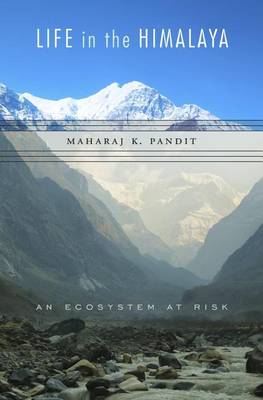
Stock image for illustration purposes only - book cover, edition or condition may vary.
Life in the Himalaya: An Ecosystem at Risk
Maharaj K. Pandit
€ 72.06
FREE Delivery in Ireland
Description for Life in the Himalaya: An Ecosystem at Risk
Hardback. The collision of the Indian and Eurasian plates 50 million years ago created the Himalaya, along with massive glaciers, intensified monsoon, turbulent rivers, and an efflorescence of ecosystems. Today, the Himalaya is at risk of catastrophic loss of life. Maharaj Pandit outlines the mountain's past in order to map a way toward a sustainable future. Num Pages: 360 pages. BIC Classification: 1FKAH; RGC. Category: (P) Professional & Vocational. Dimension: 23 x 15. .
The collision of the Indian and Eurasian plates around fifty million years ago profoundly altered earth's geography and regional climates. The rise of the Himalaya led to intensification of the monsoon, the birth of massive glaciers and turbulent rivers, and an efflorescence of ecosystems along the most extreme elevational gradient on Earth. When the Ice Age ended, humans became part of this mix, and today nearly one quarter of the world's population inhabits its river basins, from Afghanistan to Myanmar. Life in the Himalaya examines the region's geophysical and biological systems and explores the past and future of human sustainability in the mountain's shadow. Maharaj Pandit divides the Himalaya's history into four phases. During the first, the mountain and its ecosystems formed. In the second, humans altered the landscape, beginning with nomadic pastoralism, continuing to commercial deforestation, and culminating in pockets of resistance to forest exploitation. The third phase saw a human population explosion, accompanied by road and dam building and other large-scale infrastructure that degraded ecosystems and caused species extinctions. Pandit outlines a future networking phase which holds the promise of sustainable living within the mountain's carrying capacity. Today, the Himalaya is threatened by recurrent natural disasters and is at risk of catastrophic loss of life. If humans are to have a sustainable future there, Pandit argues, they will need to better understand the region's geological vulnerability, ecological fragility, and sociocultural sensitivity. Life in the Himalaya outlines the mountain's past in order to map a way forward.
Product Details
Publisher
Harvard University Press
Format
Hardback
Publication date
2017
Condition
New
Weight
28g
Number of Pages
360
Place of Publication
Cambridge, Mass, United States
ISBN
9780674971745
SKU
V9780674971745
Shipping Time
Usually ships in 7 to 11 working days
Ref
99-50
About Maharaj K. Pandit
Maharaj K. Pandit is Dean of the Faculty of Science and Professor of Environmental Studies at the University of Delhi, and a Radcliffe Fellow at Harvard University. Peter H. Raven is George Engelmann Professor Emeritus of Botany, Washington University in St. Louis, and President Emeritus of the Missouri Botanical Garden. Kamal Bawa is Distinguished Professor of Biology at the University of Massachusetts Boston.
Reviews for Life in the Himalaya: An Ecosystem at Risk
In an engrossing narrative, Maharaj K. Pandit integrates biology and Earth sciences to explain how the unique Himalayan flora came to be and what we must do to conserve this biological treasure for future generations.
Andrew Knoll, Harvard University In this book, Maharaj K. Pandit, who grew up in the west Himalayas and conducted his Ph.D. research in the east Himalayas, brings an informed perspective on Himalayan history. Emphasizing people's relationships with the mountains, Pandit discusses past phases of development and suggests a future of sustainable living. This book is a valuable contribution to our understanding of this threatened region.
Trevor Price, University of Chicago Travel buffs, interdisciplinary researchers, and those who want to explore this beautiful, vast and magnificent mountain range will find the book fascinating.
Monika Koul Current Science (11/25/2017) Pandit has lucidly presented an overall picture of the past, present and likely future of the Himalayan ecosystems by combining anthropological, biological, ecological, socio-cultural and geological literature.
Kumar Manish Frontiers in Ecology and Evolution (09/15/2017) Life in the Himalaya is a book true to its title. It'll answer your questions about the region and better still, raise questions that would have never occurred to you...The book is nothing less than a weekend retreat to the mountains.
(10/15/2017)
Andrew Knoll, Harvard University In this book, Maharaj K. Pandit, who grew up in the west Himalayas and conducted his Ph.D. research in the east Himalayas, brings an informed perspective on Himalayan history. Emphasizing people's relationships with the mountains, Pandit discusses past phases of development and suggests a future of sustainable living. This book is a valuable contribution to our understanding of this threatened region.
Trevor Price, University of Chicago Travel buffs, interdisciplinary researchers, and those who want to explore this beautiful, vast and magnificent mountain range will find the book fascinating.
Monika Koul Current Science (11/25/2017) Pandit has lucidly presented an overall picture of the past, present and likely future of the Himalayan ecosystems by combining anthropological, biological, ecological, socio-cultural and geological literature.
Kumar Manish Frontiers in Ecology and Evolution (09/15/2017) Life in the Himalaya is a book true to its title. It'll answer your questions about the region and better still, raise questions that would have never occurred to you...The book is nothing less than a weekend retreat to the mountains.
(10/15/2017)
